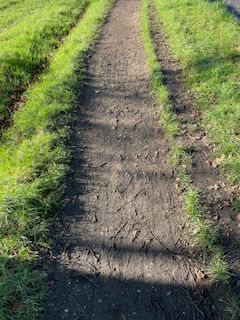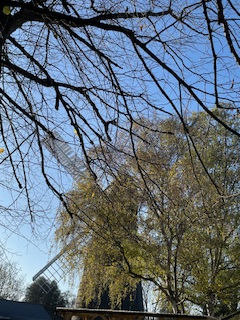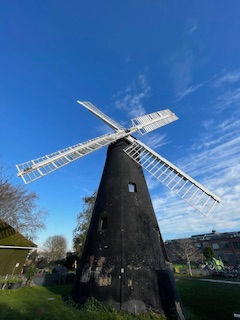Wells, Windmills and Wandering
- byways
- Oct 27
- 4 min read
Updated: 6 days ago
Wells and windmills - so evocative of times gone by. Nursery rhymes and fairy tales have them - and here in London there are some that have been preserved and can be visited.
On an Autumn day I set off to Barnet to find the well that Samuel Pepys had visited over three hundred years before. On the way I came across this ancient iron wayside marker and stopped to try to see what it was but it remains a mystery to me.

Then at the bottom of a steep hill and a climb up another I turned the corner and there it was - Barnet Well.
A small Tudor style building protects what is hidden underneath - a physic well which as well as providing fresh drinking water also contained minerals health giving minerals which was the reason Pepys came back here for a second visit.

The building may look ancient but it is not Tudor or even very old. What is very, very old though is the reason why this well is located in Barnet. Going back thousands of years, a ridge of dry gravel was created at the end of the ice age and centuries ago this formed the base for the London to York Road.
Rain water permeates the gravel but cannot soak through the London clay below and so springs are formed, and the water flows beneath the ground.
Inside the building there is a sub terranean brick chamber down some steep steps where the well water can be found.

High Barnet Station Buses 243 263 307 384
There was another well which I wanted to find - but this would be hidden away amongst woodlands on Wimbledon Common. I followed a path in the direction of the well, constantly checking that the Sun was on my left so that I was heading West.
The path was a desire path. Not planned or laid down but formed by the constant footsteps of people. And here alongside - a narrow ridge to the right, a feature which is becoming more and more common as cycling becomes increasingly popular.

At last, I came across the well, surrounded by tall fir trees as though they were guarding this site.

From this spot I crossed over the common to the windmill. Now the weather was beginning to cloud over but over to the West there was the promise of blue sky.
I had hoped to see the sails of the windmill turning but there was only a gentle breeze - not sufficient to turn the sails but enough to blow away the clouds that had gathered around it. I could see the windmill, hiding behind the trees on the edge of the common as I followed the path to its door.

As I approached it, the clouds began to part - as if some mysterious force knew that it was soon time to open for visitors.

And now - here it was. Wimbledon Windmill, which only survived the eighteenth century because of the bold efforts of local people who preserved the common for everyone, against the powerful interests of a wealthy family who owned this land.

Inside there were millstones and equipment used by the miller - and, quite unexpectedly, a cosy room in one of the corners.

When the windmill was no longer used for milling flour, it was used to house families. Each room had a window and a fire place. In modern times, we are used to people with money to spare who buy unusual buildings and convert them into luxury accomodation for just themselves but here there were six families living in the nineteenth century.

Each room had a sink - saving a trip to the water pump. It may look very basic to us but this would have been a very welcome addition for the people who lived here.

In this room there was a painting of the windmill so we can see how it looked in days gone by.

And outside there were millstones in the yard and this ancient cart.
Wimbledon Station buses 93 493 200
Soon it would be time to visit another London windmill - this time in an even more surprising location: Brixton. As I turned off the main road I very quickly came across a small park and could see the windmill behind some trees.

As I arrived at the windmill, I noticed a door where I could picture a miller dropping sacks full of flour into a cart with a horse ready to pull it all the way to the bake house.

I walked around to the front of the windmill and realised that I was standing on a hill and looking up at it. There was something strange and even other worldly about this view.

Visiting a windmill is a trip into the past and there is something almost spellbinding about this structure - its beauty, simplicity and ability to use only the wind to power the millstones.
And the wells in London take us back even further into times gone by and their allure has tempted me out on Autumn days, wandering across London to discover these ancient sites, enigmatic and enchanting - and enduring.
Brixton Station buses 45 59 109 133 159 250 333
#Brixtonwindmill #Londonwindmills #windmills






Comments